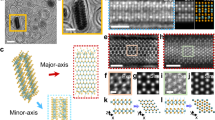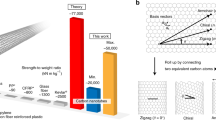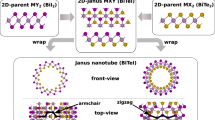Abstract
Carbon nanotubes1 have unique mechanical, electronic, optical and thermal properties, which make them attractive building blocks in the field of nanotechnology2. However, their organization into well-defined straight or curved geometries and arrays on surfaces remains a critical challenge for their integration into functional nanosystems. Here we show that combined surface- and flow-directed growth enable the controlled formation of uniquely complex and coherent geometries of single-walled carbon nanotubes, including highly oriented and periodic serpentines and coils. We propose a mechanism of non-equilibrium self-organization3, in which competing dissipative forces of adhesion and aerodynamic drag induce oscillations in the nanotubes as they adsorb on the surface. Our results demonstrate the use of ‘order through fluctuations’3 to shape nanostructures into complex geometries. The nanotube serpentines and loops are shown to be electrically conducting and could therefore find a wide range of potential applications, such as receiving and transmitting antennas, heating and cooling elements, optoelectronic devices and single-molecule dynamos.
This is a preview of subscription content, access via your institution
Access options
Subscribe to this journal
Receive 12 print issues and online access
$259.00 per year
only $21.58 per issue
Buy this article
- Purchase on Springer Link
- Instant access to full article PDF
Prices may be subject to local taxes which are calculated during checkout




Similar content being viewed by others
References
Iijima, S. Helical microtubules of graphitic carbon. Nature 354, 56–58 (1991).
Jorio, A., Dresselhaus, M. S. & Dresselhaus, G. (eds) Carbon Nanotubes: Advanced Topics in the Synthesis, Structure, Properties and Applications. Series: Topics in Applied Physics, Vol. 111 (Springer, Heidelberg, 2008).
Nicolis, G. & Prigogine, I. Self-Organization in Non-Equilibrium Systems: From Dissipative Structures to Order through Fluctuations (John Wiley, New York, 1977).
Springel, V., Frenk, C. S. & White, S. D. M. The large-scale structure of the Universe. Nature 440, 1137–1144 (2006).
Werner, B. T. Complexity in natural landform patterns. Science 284, 102–104 (1999).
Vollbrecht, E. et al. Architecture of floral branch systems in maize and related grasses. Nature 436, 1119–1126 (2005).
Lumelsky, N. et al. Differentiation of embryonic stem cells to insulin-secreting structures similar to pancreatic islets. Science 292, 1389–1394 (2001).
Whitesides, G. M. & Grzybowski, B. Self-assembly at all scales. Science 295, 2418–2421 (2002).
Avouris, P. Molecular electronics with carbon nanotubes. Acc. Chem. Res. 35, 1026–1034 (2002).
Liu, J. et al. Controlled deposition of individual single-walled carbon nanotubes on chemically functionalized templates. Chem. Phys. Lett. 303, 125–129 (1999).
Diehl, M. et al. Self-assembled, deterministic carbon nanotube wiring networks. Angew. Chem. Int. Edn 41, 353–356 (2001).
Krupke, R., Hennrich, F., von Lohneysen, H. & Kappes, M. M. Separation of metallic from semiconducting single-walled carbon nanotubes. Science 301, 344–347 (2003).
Joselevich, E. & Lieber, C. M. Vectorial growth of metallic and semiconducting single-wall carbon nanotubes. Nano Lett. 2, 1137–1141 (2002).
Huang, S., M. Cai, X. Y. & Liu, J. Growth of millimeter-long and horizontally aligned single-walled carbon nanotubes on flat substrates. J. Am. Chem. Soc. 125, 5636–5637 (2003).
Ismach, A., Segev, L., Wachtel, E. & Joselevich, E. Atomic-step-templated formation of single wall carbon nanotube patterns. Angew. Chem. Int. Edn 43, 6140–6143 (2004).
Ismach, A., Kantorovich, D. & Joselevich, E. Carbon nanotube graphoepitaxy: Highly oriented growth by faceted nanosteps. J. Am. Chem. Soc. 127, 11554–11555 (2005).
Han, S., Liu, X. L. & Zhou, C. W. Template-free directional growth of single-walled carbon nanotubes on a- and r-plane sapphire. J. Am. Chem. Soc. 127, 5294–5295 (2005).
Ago, H. et al. Aligned growth of isolated single-walled carbon nanotubes programmed by atomic arrangement of substrate surface. Chem. Phys. Lett. 408, 433–438 (2005).
Kocabas, C. et al. Guided growth of large-scale, horizontally aligned arrays of single-walled carbon nanotubes and their use in thin-film transistors. Small 1, 1110–1116 (2005).
Ismach, A. & Joselevich, E. Orthogonal self-assembly of carbon nanotube crossbar architectures by simultaneous graphoepitaxy and field-directed growth. Nano Lett. 6, 1706–1710 (2006).
Rueckes, T. et al. Carbon nanotube-based nonvolatile random access memory for molecular computing. Science 289, 94–97 (2000).
Refael, G., Heo, J. S. & Bockrath, M. Sagnac interference in carbon nanotube loops. Phys. Rev. Lett. 98, 246803 (2007).
Wang, Y. et al. Controlling the shape, orientation, and linkage of carbon nanotube features with nano affinity templates. Proc. Natl Acad. Sci. USA 103, 2026–2031 (2006).
Tsukruk, V., Ko, H. & Peleshanko, S. Nanotube surface arrays: Weaving, bending, and assembling on patterned silicon. Phys. Rev. Lett. 92, (2004).
Duggal, R. & Pasquali, M. Dynamics of individual single-walled carbon nanotubes in water by real-time visualization. Phys. Rev. Lett. 96, 246104 (2006).
Hertel, T., Walkup, R. E. & Avouris, P. Deformation of carbon nanotubes by surface van der Waals forces. Phys. Rev. B 58, 13870–13873 (1998).
Kurin-Csorgei, K., Epstein, I. R & Orban, M. Systematic design of chemical oscillators using complexation and precipitation equilibria. Nature 433, 139–142 (2005).
Bachtold, A. et al. Scanned probe microscopy of electronic transport in carbon nanotubes. Phys. Rev. Lett. 84, 6082–6085 (2000).
Kang, S. et al. High-performance electronics using dense, perfectly aligned arrays of single-walled carbon nanotubes. Nature Nanotech. 2, 230–236 (2007).
Wang, Y. et al. Receiving and transmitting light-like radio waves: Antenna effect in arrays of aligned carbon nanotubes. Appl. Phys. Lett. 85, 2607–2609 (2004).
Acknowledgements
This research was supported by the Israel Science Foundation, the US–Israel Binational Science Foundation, the Kimmel Center for Nanoscale Science, and the Djanogly, Alhadeff and Perlman Family foundations. E.J. holds the Victor Erlich Career Development Chair. We thank A. Jorio, G. Cançado and L. Novotny for Raman characterization, R. Popovitz-Biro for TEM characterization, A. Yoffe for assistance with the cleanroom facilities, R. Naaman for allowing us to use his electrical probe station, and N. Gov, K.S. Nagapriya and T. Yarden for helpful discussions.
Author information
Authors and Affiliations
Corresponding author
Rights and permissions
About this article
Cite this article
Geblinger, N., Ismach, A. & Joselevich, E. Self-organized nanotube serpentines. Nature Nanotech 3, 195–200 (2008). https://doi.org/10.1038/nnano.2008.59
Received:
Accepted:
Published:
Issue Date:
DOI: https://doi.org/10.1038/nnano.2008.59
This article is cited by
-
Controlled growth of crossed ultralong carbon nanotubes by gas flow
Nano Research (2020)
-
Rate-selected growth of ultrapure semiconducting carbon nanotube arrays
Nature Communications (2019)
-
Preparation of horizontally aligned single-walled carbon nanotubes with floating catalyst
Science China Chemistry (2017)
-
Preparation of Horizontal Single-Walled Carbon Nanotubes Arrays
Topics in Current Chemistry (2016)
-
Curved carbon nanotubes: From unique geometries to novel properties and peculiar applications
Nano Research (2014)



